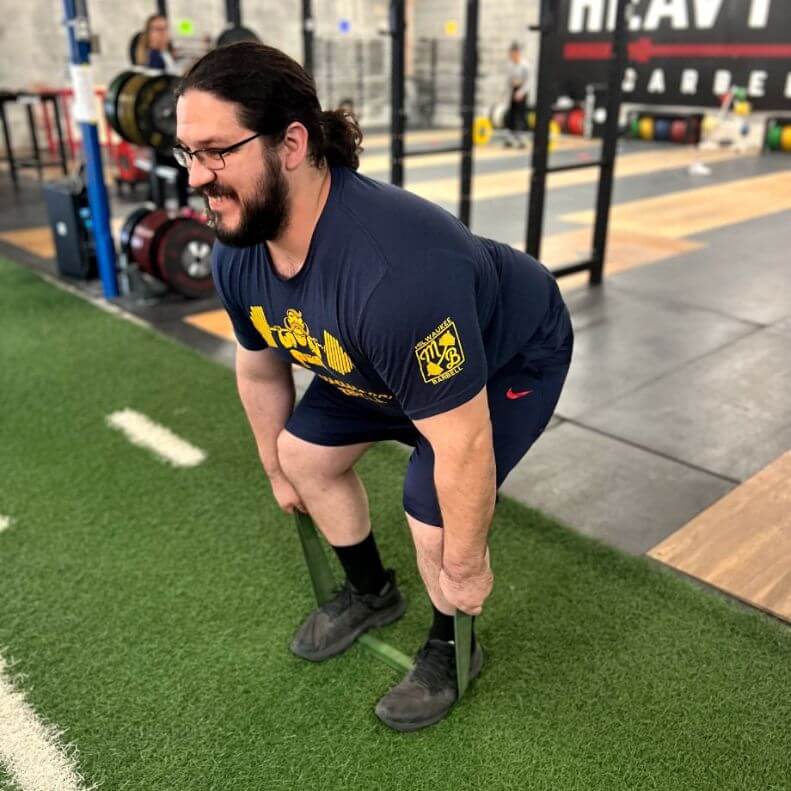We test and review fitness products based on an independent, multi-point methodology. If you use our links to purchase something, we may earn a commission. Read our disclosures.
One of the simplest ways of improving your weightlifting and enhancing your quality of life involves heeding the iconic advice of Happy Gilmore’s Chubbs Peterson—“It’s all in the hips.”
That’s right; hip hinge exercises can work wonders for strengthening your hamstrings, helping improve your biomechanics, increasing your power output, and alleviating your lower back pain. The movement is easy to learn and yields massive benefits in the weight room, on the playing field, and in everyday life.
RELATED: Hamstring Exercises At Home
Amanda Capritto, CPT, CES, CNC, CF-L1, and GGR Senior Staff Writer, shares how to develop a great hip hinge and 16 hip-focused exercises that’ll help you perfect this essential movement.
What Is a Hip Hinge?
The hip hinge is a glute and hamstring exercise that involves bending forward while maintaining a neutral spine position.
“If you want to make sure you’re doing the hip hinge correctly, try using a wooden dowel or length of PVC pipe,” says Amanda. “Hold the dowel behind your back so that it touches the back of your head, your upper back, and where your lower back meets your butt. It should be touching these three locations throughout the full range of motion if you’re doing it right.”
The hip hinge targets posterior chain muscles, including the glutes, hamstrings, and erector spinae, while the neutral spine position minimizes risk of injury to the lumbar spine.
RELATED: Lower Back Exercises
Why Everyone Needs to Train The Hip Hinge
Athletes, bodybuilders, and powerlifters need an efficient hip hinge for strength training movements, but they’re not the only ones who benefit from a good hip hinge.
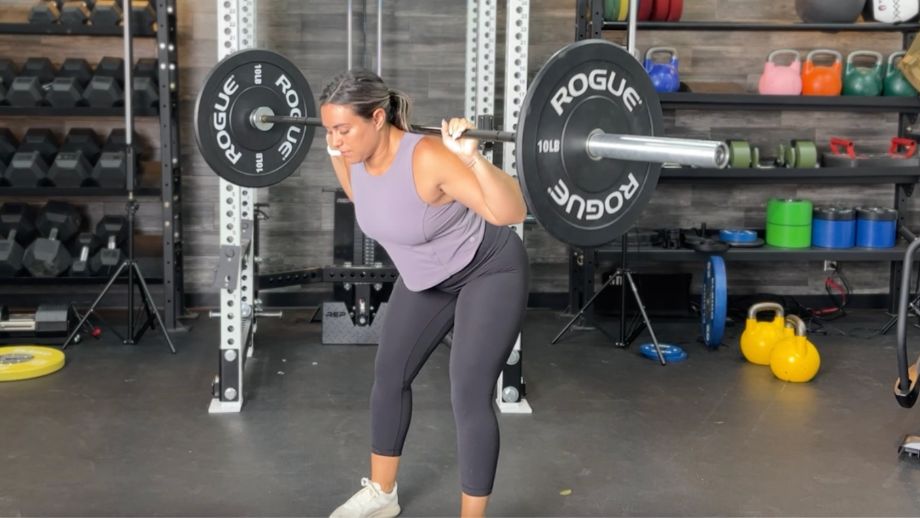
“The hip hinge is a fundamental movement pattern used regularly for everyday activities,” says Amanda Capritto, CPT, CES, CNC, CF-L1. “Everytime you bend forward without squatting, that’s a hip hinge. Reaching down for your grocery bags, bending to get that toy your kid left in the middle of the floor—hip hinge.”
RELATED: Benefits of Strength Training
That’s why it’s important to train your hip hinge, even if you don’t identify as an athlete.
Plus, there are numerous benefits associated with practicing and perfecting the hip hinge exercise. Studies show1 that hip hinge movements increase core stability, which can help alleviate low back pain, improve balance, and enhance trunk movement mechanics, increasing flexion, extension, and rotation.
A 2021 study published in Sensors (Basel)2 also found that “a good hip hinge” was an important factor in reducing your overall risk of lower back injury.
So, whether you’re an athlete looking to lift heavier or just seeking to stave off lower back pain (perhaps from sitting at a desk all day?), it’s worth your while to develop a good hip hinge.
Beginner Hip Hinge Exercises
If you’re new to the hip hinge, start out with these beginner movements.
Just The Hinge
Why we like it: “It’s important to rehearse the fundamentals before adding in resistance,” says Amanda Capritto, CPT, CES, CNC, CF-L1. “Starting with just the hinge lets you practice pushing the hips back, incorporate a soft bend in the knee, and get the positioning perfect before progressing.”
How to do it:
- Stand with your feet shoulder-width apart.
- Push your hips and butt back as you hinge forward at the hips. Keep your back straight, your weight on your heels, and a slight bend in the knees.
- Continue until your torso is nearly parallel with the floor.
- Pause, then extend your hips to return to the starting position.
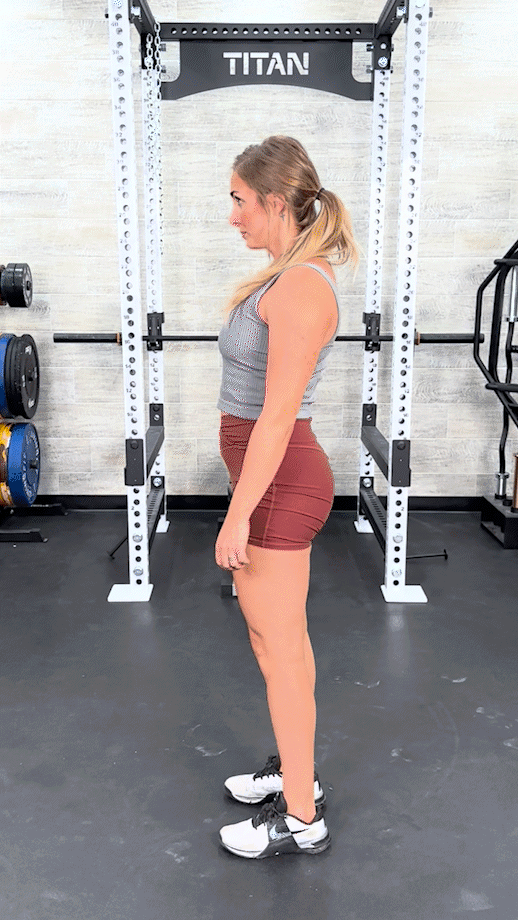
Kettlebell Hip Hinge Drill
Why we like it: Adding a kettlebell helps get you accustomed to working with weights while focusing solely on the hip hinge portion of the movement. The kettlebell swing portion will come later.
How to do it:
- Hold a kettlebell in front of your body with both hands.
- Push your hips back and hinge forward.
- Keep going until your chest forms roughly a 45-degree angle, then thrust your hips forward, coming to full extension, and contract the glutes.
RELATED: Best Kettlebells
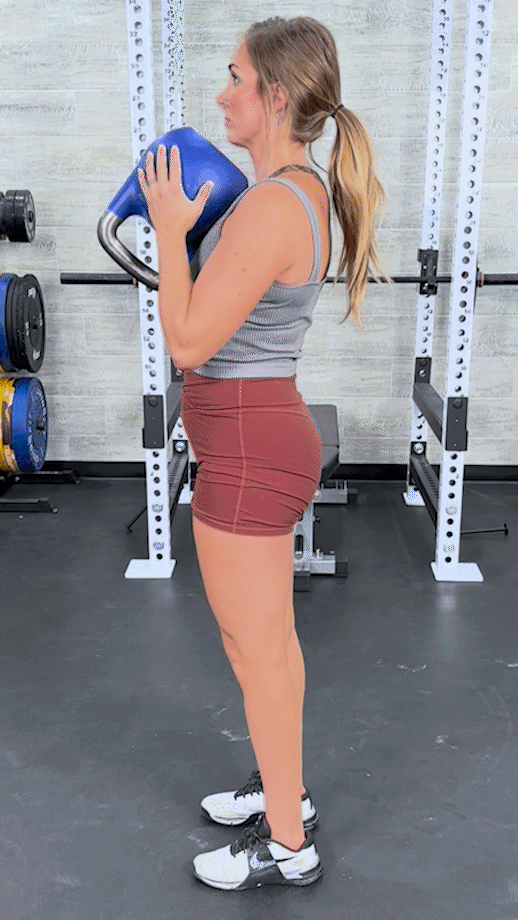
Resistance Band Hip Hinge Drill
Why we like it: “Resistance bands impose dynamic resistance,” says Amanda, “which requires core stability and strength in order to complete the hip hinge motion properly.”
How to do it:
- Secure a resistance band to an anchor point behind you and wrap it around your hips.
- Step forward to create tension, then perform the hip hinge movement as normal, moving slowly to maintain proper hip hinge form against the pull of the resistance band.
RELATED: Best Resistance Bands
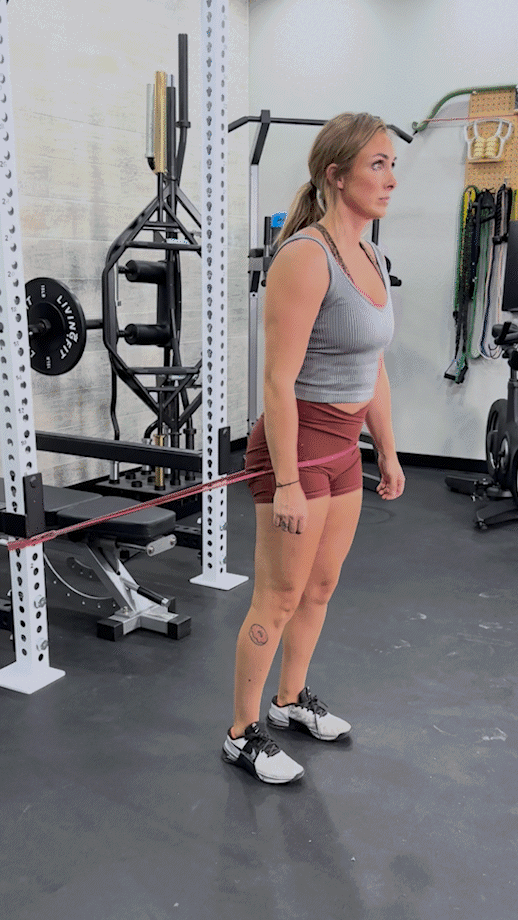
Bodyweight Glute Bridge
Why we like it: Lying down during bodyweight glute bridges lets you really flex those glutes and improve hip mobility. It’s a great warm up before more advanced hip hinge movements.
How to do it:
- Lie on an exercise mat with your feet on the floor and your knees bent.
- Thrust your hips upward, bringing your butt off the floor, and squeezing your glutes.
- Hold for the desired duration, then release.
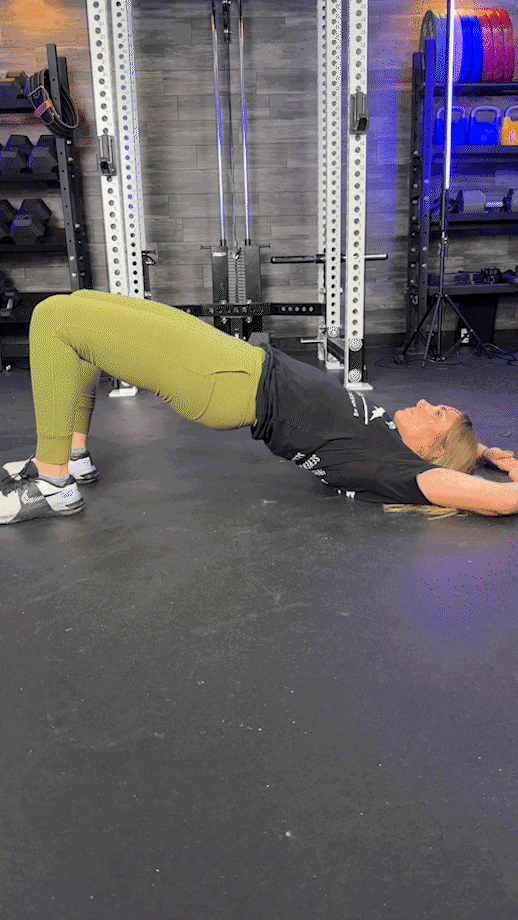
Russian Kettlebell Swing
Why we like it: The Russian kettlebell swing isn’t only a full-body compound movement3 that also happens to provide a “vigorous cardiovascular response4;” it’s also a hip hinge movement.
How to do it:
- Hold a kettlebell with two hands just below your hips. Keep your feet shoulder-width apart, your back straight, and your core muscles flexed.
- Hinge forward, then thrust your hips to propel the kettlebell upward.
- Guide the kettlebell as it travels to chest height, squeezing your glutes at the top.
- Control the kettlebell on the descent so that it swings through your legs and behind you, hinging forward again to accommodate the kettlebell’s movement.
- Thrust your hips forward again to cycle into the next rep.
RELATED: Kettlebell Swings
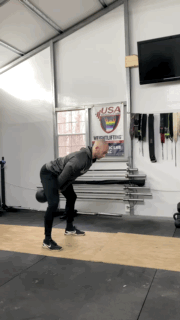
Kettlebell Deadlift
Why we like it: “The kettlebell deadlift is a great introduction to deadlifts in general,” says Amanda. “It targets the same posterior chain muscles, but puts less strain on your lower back.”
How to do it:
- Place a kettlebell on the floor between your legs.
- Hinge forward and bend your knees to grab the kettlebell handle with both hands. Keep your back straight, shoulder blades pinched, and eyes fixed dead ahead.
- Tighten your core and push through your heels to reach a standing position, bringing your hips forward as the kettlebell passes knee height. Squeeze your glutes at the top.
- Reverse the movement to lower the kettlebell back down.
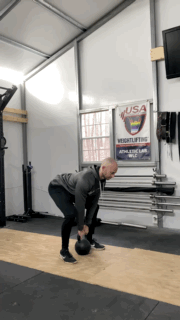
Intermediate Hip Hinge Exercises
After you’re well-acquainted with the basic movement mechanics of the hip hinge, we’re going to advance to some basic lifts.
Barbell Conventional Deadlift
Why we like it: “The standard barbell deadlift produces muscle activation throughout the whole body while building a powerful hip hinge movement,” says Amanda. “It’s one of the best exercises no matter what your fitness goals are.”
RELATED: Deadlift Muscles Worked
How to do it:
- Stand with your feet shoulder-width apart and a loaded barbell in front of you.
- Reach down to grip the bar using an overhand, hook, or mixed grip.
- Keeping the bar close to your body, drive from your heels to stand.
- As the bar passes knee height, bring your hips forward to a full hip extension.
- Squeeze your glutes, then slowly return to the starting position.
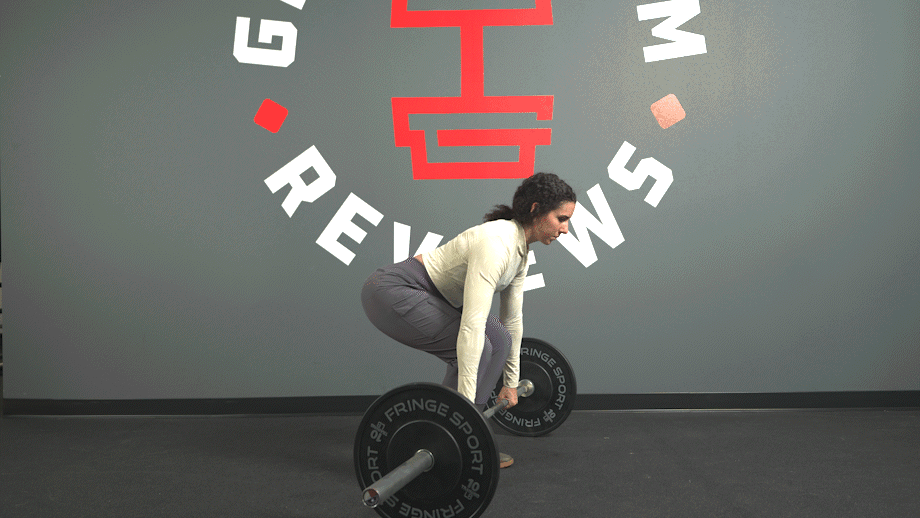
Barbell Romanian Deadlift
Why we like it: The Romanian deadlift, often abbreviated as RDL, flips the deadlift’s movement pattern on its head. A 2020 PLoS One study5 shows this switch increases the hamstring activation, ultimately contributing to a more powerful hip hinge.
How to do it:
- Stand with your feet hip-width apart while holding a loaded barbell.
- Lower the barbell towards the floor, bringing your hips back and chest down.
- Continue until you feel a stretch in your hamstrings.
- Drive through your heels to stand back up.
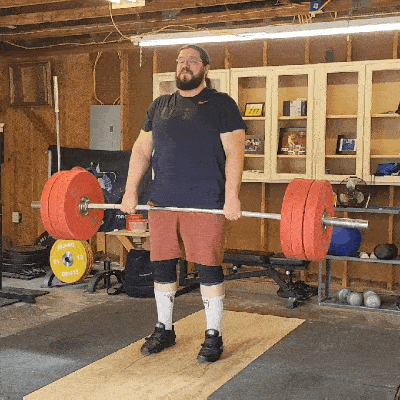
Resistance Band Good Morning
Why we like it: “The bodyweight good morning exercise targets muscles like the lower back, spinal erectors, glutes, and hamstrings, “ says Amanda, “Using a resistance band makes the movement more impactful overall.”
How to do it:
- Step on a resistance band and hinge forward.
- Loop the other end of the resistance band around your shoulders and upper back.
- Bring the hips forward to full extension, standing tall.
- Hinge forward to return to the starting position.
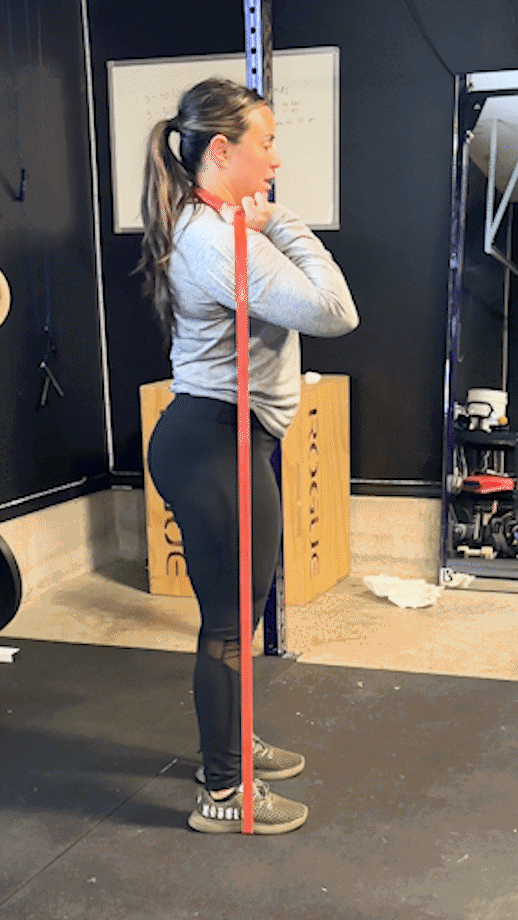
Kettlebell Good Morning
Why we like it: “Kettlebell good mornings add resistance using free weights,” says Amanda. “You can use a kettlebell, dumbbell, or any object around the house in a pinch.”
How to do it:
- Hold the kettlebell to your chest.
- Push your hips back, bringing your chest down until it’s almost parallel with the floor.
- Pause at the bottom, then bring your hips forward again.
RELATED: Best Dumbbells
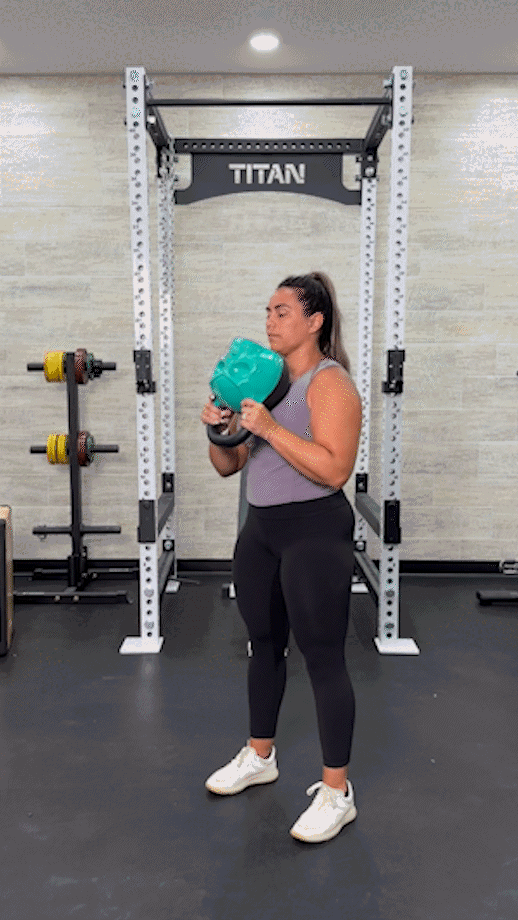
American Kettlebell Swing
Why we like it: American kettlebell swings take the Russian version and increase its range of motion, putting greater emphasis on upper back muscles like the traps and lats. You’ll need an even stronger hip thrust to achieve this height.
How to do it:
- Hold a kettlebell in front of your body with both hands.
- Hinge forward, then explosively thrust your hips to propel the kettlebell upward.
- Guide the kettlebell overhead so that your biceps are next to your ears.
- Let the kettlebell fall back down in a controlled motion through your legs, hinging forward again as it falls.
- Use the kettlebell’s momentum to cycle into the next rep.
RELATED: Russian Kettlebell Swing Vs American
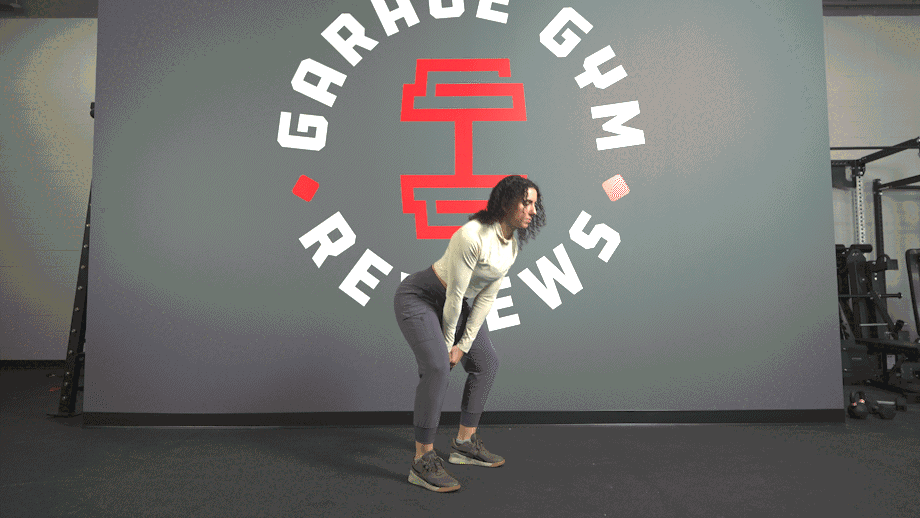
Bodyweight Hip Thrust
Why we like it: “Glute bridges are performed from the floor, while bodyweight hip thrusts use a weight bench,” says Amanda. “The added elevation increases the range of motion, making it an overall more effective movement.”
How to do it:
- Sit down with your back to a flat weight bench.
- Push your upper back into the bench and your feet into the floor to lift your hips. You should form a straight line from your upper body to your hips in the end position.
- Squeeze your glutes, then lower yourself back down. To advance the movement, try adding a resistance band.
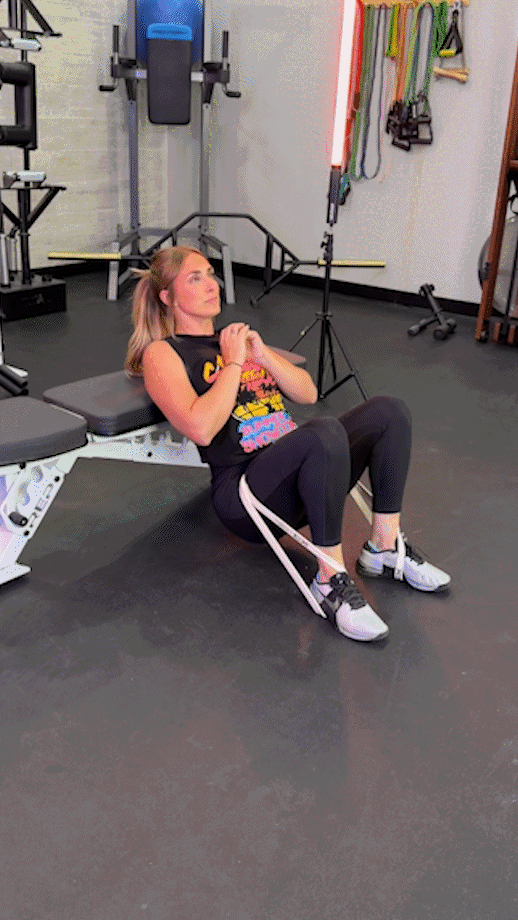
Advanced Hip Hinge Exercises
Once you’re comfortable performing the hip hinge movement while using weight, you can advance to explosive hip hinge movements, including Olympic weightlifting favorites like the clean and the snatch.
Barbell Hip Thrust
Why we like it: The barbell hip thrust is less technical than Olympic weightlifting movements while providing similar power increases. It’s also one of the best for targeting the hip extensors6.
How to do it:
- Place a loaded barbell alongside a weight bench and sit with the bench behind you.
- Roll the bar up your legs until it reaches your hip crease.
- Plant your feet and drive them into the floor to thrust your hips upward.
- Squeeze your glutes, then slowly come back down.
RELATED: Hip Thrust Workout
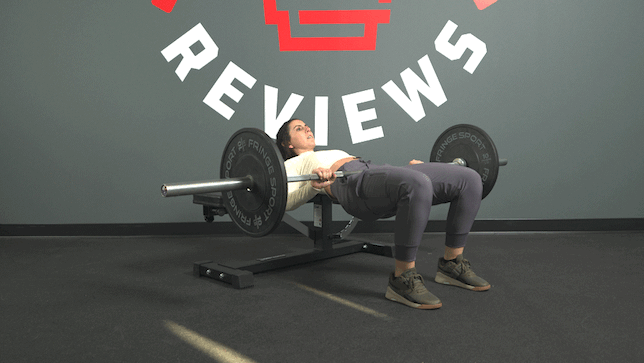
Barbell Good Morning
Why we like it: “Barbell good mornings improve hip mobility, increase core stability, and target posterior chain muscles,” says Amanda. “They also involve the hip hinge movement, which translates to improved power output.”
RELATED: Mobility Exercises
How to do it:
- Unrack a loaded barbell onto your shoulders and stand with your feet shoulder-width apart. Your knees should be slightly bent, core tight, and back straight.
- Push your hips back, bringing your chest down until it’s almost parallel with the floor.
- Pause at the bottom, then bring your hips forward to stand back up.
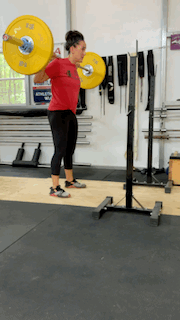
Barbell Power Clean
Why we like it: The power clean targets muscles virtually everywhere, but it’s especially excellent for improving explosive power thanks to its use of the hip hinge.
How to do it:
- Stand with a loaded barbell at your feet.
- Reach down to grip the bar with an overhand or hook grip.
- Drive through your heels and explode upward, forcefully bringing your hips forward and pulling the bar towards your chin. Keep the bar close to your body.
- Bring your elbows forward and under the bar to catch it in the front rack position.
- Drop into a partial squat to absorb the shock.
- Once the bar is stabilized, fully extend your hips and legs to finish the rep.
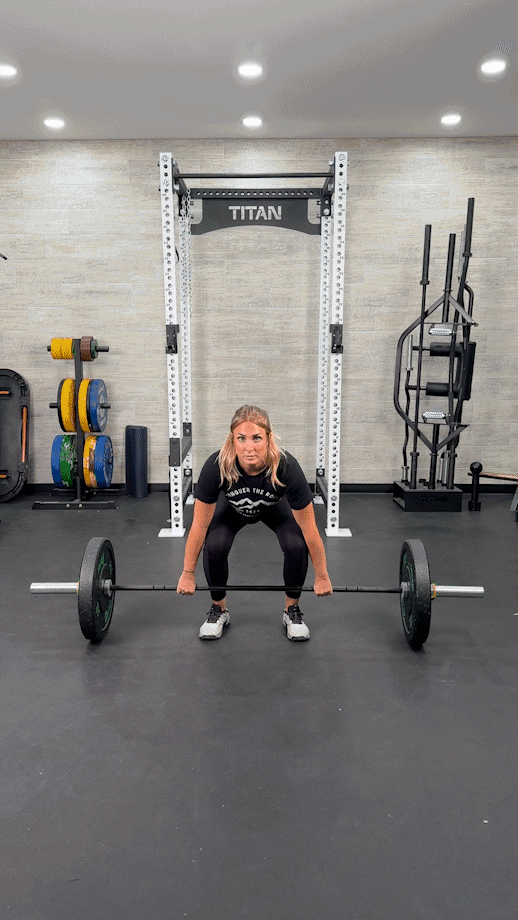
Barbell Power Snatch
Why we like it: “The snatch exercise is the best example of how a strong hip hinge can help you generate incredible power,” says Amanda. “With proper form and execution, you’re basically launching a heavy weight overhead—a feat that’d be otherwise impossible without technique.”
How to do it:
- Stand with a loaded barbell at your feet.
- Reach down and grip the bar with a wide overhand or hook grip.
- Drive through your heels and explode upward, bringing your hips forward and pulling the bar from the floor simultaneously.
- As the bar passes mid-thigh, pull your elbows high and push the bar overhead.
- Dip into a partial squat to catch the bar and stabilize.
- Once stabilized, fully extend your hips and legs to finish the rep.
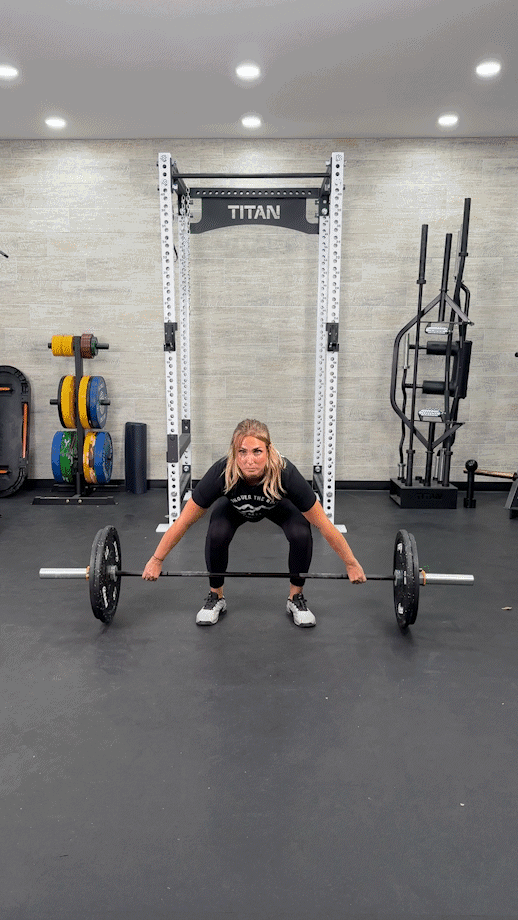
How to Incorporate Hip Hinge Exercises Into Your Workout Routine
How you incorporate hip hinge exercises into your training session depends on the exercises.
For example, exercises like the deadlift, barbell hip thrust, power clean, and power snatch are major strength-building movements. Studies show that exercises performed first during training often yield the most results7, so we recommend leading a workout with compound movements and major strength training exercises.
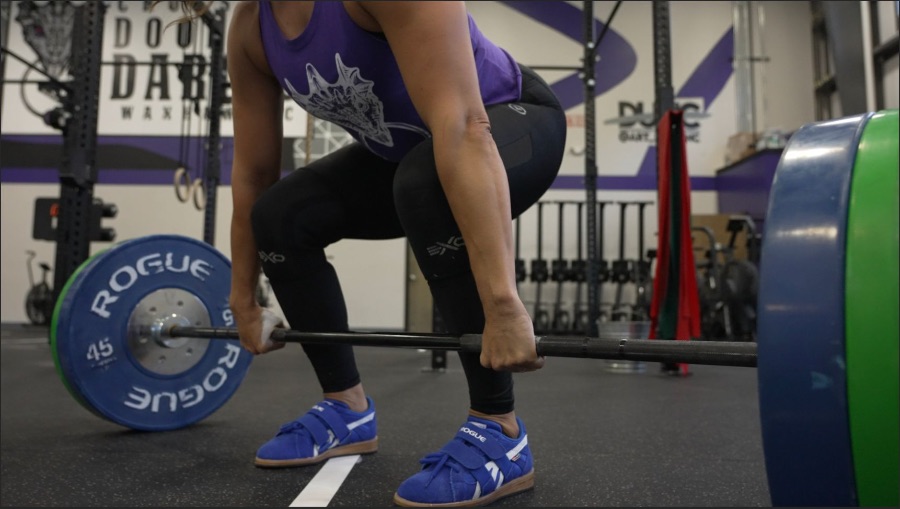
However, some exercises, like the good morning and the glute bridge, develop the hip hinge movement pattern without providing the same level of muscle activation you’d need for major strength or size gains. Exercises like these work just as well during a warm-up or cool down.
“There are a lot of different ways you can do it, depending on your goals,” says Amanda Capritto, CPT, CES, CNC, CF-L1, and GGR Senior Staff Writer. “For the best results, consider working with a coach or personal trainer.”
Hip Hinge Exercises: Final Thoughts
A great hip hinge isn’t just for sports and weightlifting; it’s an essential movement for performing everyday tasks, translating to more efficient movement mechanics and less nagging low back aches and pains.
If you’re looking to improve your fitness and enhance your overall quality of life, try working hip-hinge exercises into your workout routine.
Hip Hinge Exercises: FAQs
What is an example of a hip hinge movement?
Hip hinge exercises include the kettlebell swing, good morning, deadlift, and power clean, but everyday activities like picking up objects from the floor also involve the hip hinge movement.
What are hip hinges good for?
“Hip hinges translate to better movement mechanics and better overall power output during exercise,” says Amanda Capritto, CPT, CES, CNC, CF-L1. “They’re also good for strengthening posterior chain muscles, improving core strength, alleviating low back pain, and reducing your risk of injury.”
Is a squat a hip hinge?
The movements are similar, but a squat is not a hip hinge. Hip hinges involve bringing the hips back, while squats involve lowering the hips as if sitting in a chair.
RELATED: What Muscles Do Squats Work?
Is lunge a hip hinge?
One could argue that lunges are a type of hip hinge movement, but they’re more closely related to squats. Regardless of the official classification, squats, lunges, and hip hinges are all excellent movements to include in your workout routine.
RELATED: Your Guide to Lunges Exercise
References
1. Kim B, Yim J. Core Stability and Hip Exercises Improve Physical Function and Activity in Patients with Non-Specific Low Back Pain: A Randomized Controlled Trial. Tohoku J Exp Med. 2020;251(3):193-206. doi:10.1620/tjem.251.193
2. Michaud F, Pérez Soto M, Lugrís U, Cuadrado J. Lower Back Injury Prevention and Sensitization of Hip Hinge with Neutral Spine Using Wearable Sensors during Lifting Exercises. Sensors (Basel). 2021;21(16):5487. Published 2021 Aug 14. doi:10.3390/s21165487
3. McGill SM, Marshall LW. Kettlebell swing, snatch, and bottoms-up carry: back and hip muscle activation, motion, and low back loads. J Strength Cond Res. 2012;26(1):16-27. doi:10.1519/JSC.0b013e31823a4063
4. Fortner HA, Salgado JM, Holmstrup AM, Holmstrup ME. Cardiovascular and Metabolic Demads of the Kettlebell Swing using Tabata Interval versus a Traditional Resistance Protocol. Int J Exerc Sci. 2014;7(3):179-185. Published 2014 Jul 1.
5. Martín-Fuentes I, Oliva-Lozano JM, Muyor JM. Electromyographic activity in deadlift exercise and its variants. A systematic review. PLoS One. 2020;15(2):e0229507. Published 2020 Feb 27. doi:10.1371/journal.pone.0229507
6. Neto WK, Vieira TL, Gama EF. Barbell Hip Thrust, Muscular Activation and Performance: A Systematic Review. J Sports Sci Med. 2019;18(2):198-206. Published 2019 Jun 1.
7. Simão R, de Salles BF, Figueiredo T, Dias I, Willardson JM. Exercise order in resistance training. Sports Med. 2012;42(3):251-265. doi:10.2165/11597240-000000000-00000
Further reading

If you're limited on equipment, it can feel like you're unable to perform exercises like back extensions. But you can have it all with our tips on how to do back extensions at home! Read more

Find ways to store your gym equipment away and save space with our picks for the best garage shelving. Read more

Thanks to our readers, we receive a lot of emails showcasing the gyms they've built based on our recommendations. Here are 10 absolutely ridiculous home gym setups that we're all envious of. Read more

Are potential creatine side effects like weight gain, cramps, and kidney damage supported by science? Here’s what you need to know before you start taking creatine. Read more

